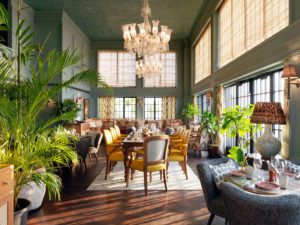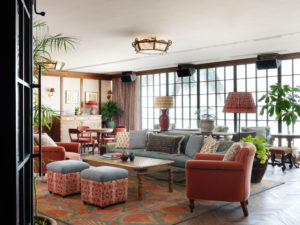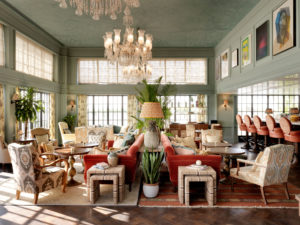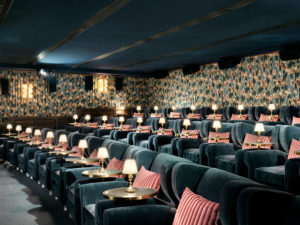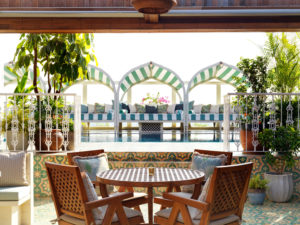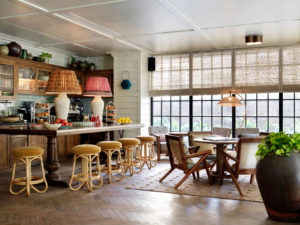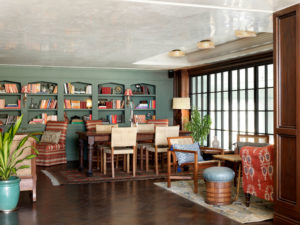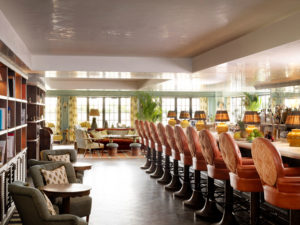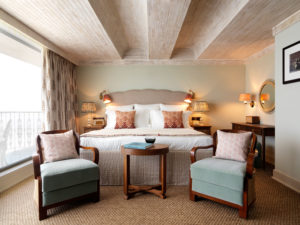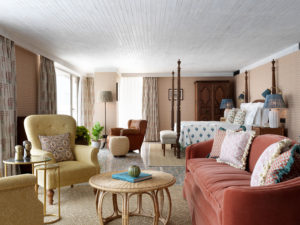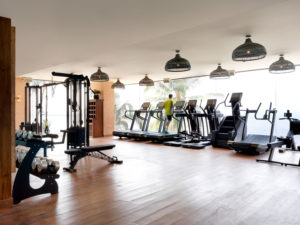There has been a buzz about it opening in the bay city for the past three years. It opened its chic doors to Mumbaikars in December 2018. Soho House Mumbai, the global private members’ club-cum-hotel’s India iteration also happens to be its first in Asia.
Main Members Space, Dining Area
A month ago, Soho House Mumbai threw the mother of all party to announce the arrival of this London icon into Mumbai. At the party were the best of the city’s glamorous crowd—from actors to artists, from filmmakers to advertising biggies, the creative class that form Soho House’s membership core across the world.
Soho House Rooftop, Bar View
Nick Jones ever-expanding global empire’s newest jewel is set in a lovely white townhouse, complete with awnings and balconies, and hugs the shimmering sands of Juhu beach with gorgeous views of the Arabian Sea and palm trees. Soho House Mumbai has been in the works for at least five years — in the luxury circles in the city, they have been talking about it opening for years. While no one is say why it took so long to open, now that it has, Mumbai is at least part of the few rare cities that has a House.
The 11-storey building stands right at the edge of Juhu beach, with sweeping sea views and the Mumbai coastline. Designed to be a luxurious ‘home away from home’, the Houses eschews the bling aesthetics that has come to define luxury in India, and keeps it earthy, natural and intimate.
Soho House Mumbai, Lounge Area
Soho House Mumbai has all the bits that Soho Houses across the world are famous for: the breezy Allis cafe, an Italian restaurant Cecconi’s (open to everyone), a space you can hire for parties and events, the 38-room hotel anyone can check into, and the private members’ areas that are off-bound for the rest of the world.
The design of the House, evolved by a team led by founder Nick Jones (every aspect of Soho House is said to be chosen by, or at the very least approved by, Jones) and director of Soho House Design, Linda Boronkay, draws inspiration from everything beautiful in the Indian design repository. There are table lamps covered in sari fabric; furniture upholstered with breezy block printed Jaipuri cotton fabrics. Patterned cement tiles and polished teak furniture informs its interiors.
Cinema on the 1st floor
The House is peppered with cut-glass chandeliers, the ones that swung from the ceilings of old homes belonging to affluent Parsis, the community which fled Persia to settle in India. The art collection, curated by head of collections for Soho House Kate Bryan, includes My Stars, a large installation by Subodh Gupta incorporating his trademark steel utensils; as well as art by leading Indian artists such as Bharti Kher, Thukral and Tagra and Princess Pea. The 38 bedrooms have eco-friendly sisal carpet flooring, antique timber, bone inlay furniture and lampshades created using antique saris.
Rooftop Pool View
Like other Soho Houses, the rooftop pool is one of Soho House Mumbai’s key features. The terrace overlooks Juhu Beach and has cane chairs made by local craftspeople, and large daybeds that are shaded by striped awning.
Anyone in the creative industry can apply for a membership—but if you have an introduction from an existing member and references, you stand a better chance. And if you are below 27 years of age, you pay half, in keeping with the policy of offering a space for the young and the creative.
Soho House Mumbai is a beautiful contrast to Mumbai’s chaotic, rushed and noisy streets. It is laidback, calm and quiet. Much like all other Soho Houses, it is cool and cosmopolitan, too.
Soho House, Mumbai, Ground Floor – The Allis
The Story of Soho Houses
What began as a space for those working in the creative community, authors, filmmakers, et al, in a quiet part of London’s Soho neighbourhood (from where it draws its name), is now a global chain of cosy and beautifully designed members’ clubs-cum-hotel-cum-hangout and networking space, with a wide suite of facilities — restaurants, spa, gym, cinema, café, workspaces and the hotel rooms (or bedrooms, as they like to call them), of course.
The aim has been for the clubs to become the physical manifestation of the social fabric, historical and cultural heritage of each and every place where they have Houses. There are over 23 Soho Houses across the world in some of the most creative destinations —Istanbul, Berlin, New York, Chicago, Barcelona, and many more.
Soho House Mumbai, The Library
Founder and CEO Nick Jones, a young restaurateur, acquired the possession of a townhouse above his French restaurant Cafe Boheme and converted it into a private club in 1995, which, over the years has evolved to include restaurants and hotels. What made Soho House stand out was its relaxed aesthetics and its membership policy, which welcomed the city’s bohemian creative community—artists, film-makers, writers and designers, in complete variance of the other private members’ clubs that largely focus on businessmen and industrialists.
Jones probably never anticipated that his offbeat London creative corner would one day acquire the shape of a global chain. Across the 23 iterations, each of them designed to reflect the city and the neighbourhood they are in—Soho House has remained true to its intended purpose of being relaxed, laid-back and fun. The idea, Jones is quoted as having said, is to try and bring the club back to its creative roots. In the times of economic downturn, in fact, Soho House in New York became the base for several precariously employed creative professionals who were looking for work and to network with their own kind.
Main Members Space, Bar Area
All Soho Houses share a few ideas— from the colour palette to the fittings, the Cowshed spa, the Cecconi’s restaurant, the no-photos policy and the rooftop pool. However, there are always a few nods to the local culture and architecture. In Barcelona, it sits on the graceful Plaça del Duc de Medinaceli, in the Gothic quarters, with the boats of Port Vell in clear view. It is more English country house in character. In Istanbul, Soho House opened in a 19th century mansion, close to the mighty Bosphorus Strait, in the Genoese (later European) quarters of the city, with views of the atmospheric Old Town. The Palazzo Corpi building it occupies was once home to powerful Genoese shipbuilder Ignazio Corpi and then occupied by the US Embassy.
Soho Ludlow House, New York is a nod to the city’s eclectic dining scene, with Lou’s Kitchen & Bar, a club bar with open kitchen that serves an all-day American Italian menu; the Velvet Room and the Dark Room or clubs within a club that also double up as space for private screenings; and a rooftop garden vegetarian Asian restaurant.
Soho House Mumbai, Big Bedroom
Much like all private members’ clubs, Soho House is a place to schmooze, but it is also a place where some serious business is conducted by people wearing distressed denims and casual summer dresses.
The future of Members-only clubs
Private social clubs were first set up by British aristocratic men in the 18th century, and soon after, their charm wooed the world. Netflix’s popular show The Crown, which brought to life the secretive world of British royalty, featured a version or two of such clubs, frequented and even founded by Prince Philip, Duke of Edinburgh, back then. A flock of elite clubs for the highly privileged across major cities, including New York, has pretty much been a norm since then.
They were once elite spaces to which not everyone had access. Today, there is a Soho House pretty much in every city; Nick Jones must be running out of cool cities to set up another Soho House in, which, perhaps, explains why some cities have more than one Houses.
Soho House Mumbai, Playroom
Now there are private members’ clubs pretty much across the world. 5 Hertford Street, one of London’s fabled members’ clubs, stands hidden behind maroon doors and a Georgian façade. Within those hallowed walls are private dining rooms, a cigar store, and a wine bar that serves Davidoff Dom Pérignon, among other rare worthies. Its waiting list has over 3,000 applicants.
In London, itself, there is Brooks’, among the oldest in the world, established in 1762 as a private society. Today it is housed in a grand yellow-brick and Portland stone building, it imitates the Palladian style of early Dutch country houses, and offers its members access to a bar, dining room, library, and several gaming rooms. Among its alumni is former Prime Minister William Pitt the Younger, and slave trade abolitionist leader William Wilberforce.
The Yale Club of New York City has a 120-year-old journey, opening its doors in 1915, at 17 Madison Square. The Club now sits on Vanderbilt Avenue, in the heart of midtown, and is just steps away from the Grand Central Station. Hailed for its refined neoclassical approach, it was designed by James Gamble Rogers. Sydney’s The Australian Club, founded in 1838, has immaculate views of the Botanic Gardens and North Shore. The Club provides scrumptious dining, ensuite bedrooms and apartments, a gym, and top-notch business facilities.
Soho House Mumbai, Gym Area
Mumbai itself has more than one private members’ club. Among its leading offerings is The A, a plush club designed with all black leather, chrome and beautiful lights. There is a lounge area, The Alcove, where you can work, or network, or just lounge, which segues into another fancy bar, an event space, besides a few work studios. There are breakout spaces in form of designer loungers or pods, where, ensconced in your private world, a member can watch a movie or listen to music. In the rarefied world of private members’ clubs, you don’t have to step out for anything. There are chefs, an in-house restaurant, and a brew area that serves all of a member’s needs, including indulging him with Dark Matter, a brand that offers offbeat coffee options, including barrel-aged, cask-conditioned coffees.
With clubs opening all over the world, its naysayers are asking a pertinent question: does holding a key to a private club carry the cultural cache it once did?

